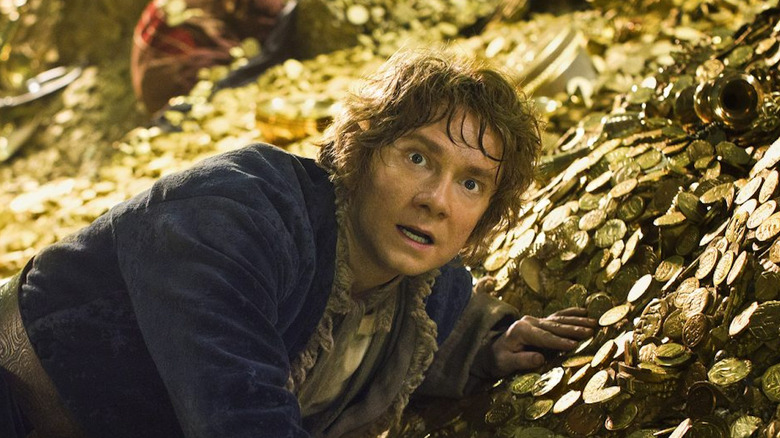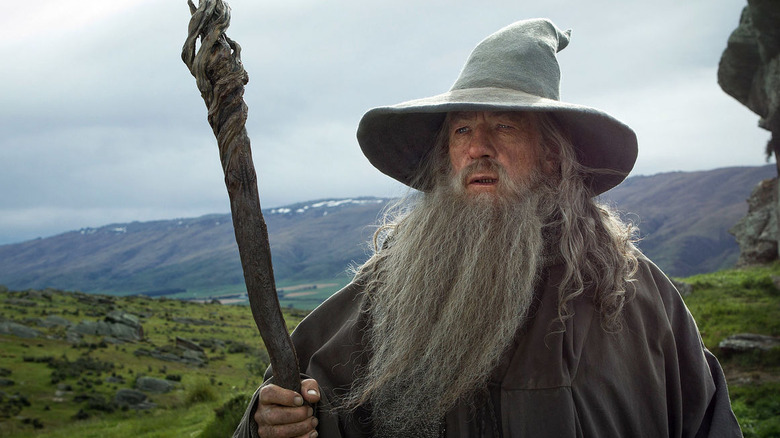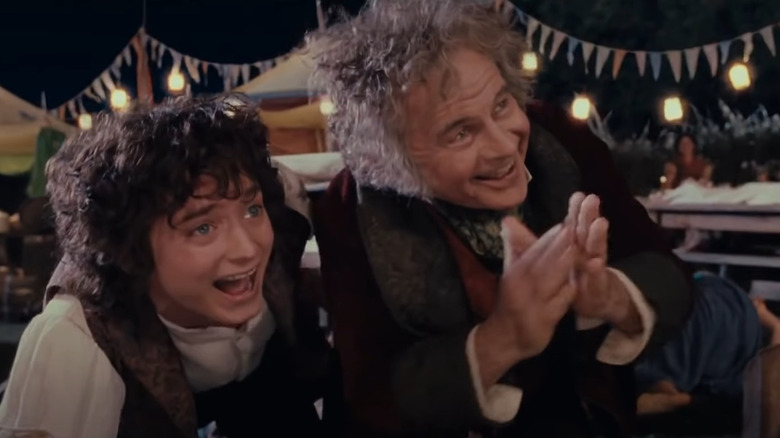The Lord Of The Rings: How Many Years After The Hobbit Is The Trilogy Set?
Both "The Hobbit" and "The Lord of the Rings" events take place in short windows of time, considering the scope of their stories. "The Hobbit" spans roughly a single year. "The Lord of the Rings" is a little trickier to track. However, the stretch of time from Frodo's departure from Bag End until the One Ring is destroyed takes just over half a year — six months and two days, to be precise.
The short time frames make the span of time between the two stories a bit surprising. There is over a 76-year gap between the end of Bilbo's round-trip to the Lonely Mountain and the beginning of Frodo's own perilous journey. As is no surprise to those familiar with J.R.R. Tolkien's ridiculously detailed texts, we can get pretty specific about the nitty-gritty dates here, too.
In the last chapter of "The Hobbit," it says that Bilbo arrives back in the Shire on June 22 of the 2,942nd year of the Third Age (TA) — this is the same day that his house is being put up for auction. Frodo decides to leave Bag End to start his quest the day after his and Bilbo's shared birthday — that is, September 23 — in the year 3018 TA. That puts the event 76 years, three months, and one day after Bilbo's auction.
Of course, Tolkien often treated his works as historical narratives. As such, he often included chunks of stories both before and after the main events. When you take these into consideration, the specific start and end dates can vary quite a bit.
The literal time between the tales
If you want to count the literal time between the two tales, you need to skip ahead to the last pages of "The Hobbit." These say that, "One autumn evening some years afterwards" Gandalf and Balin visit Bilbo. The appendices of "The Return of the King" clarify that this event happens seven years after the main story ends, in the year 2949 TA.
As far as "The Lord of the Rings" is concerned, the story technically begins with a rapid summary of Bilbo's later years, outlining how he brings Frodo to live with him at Bag End. However, within a page, the story skips forward 12 years to 3001 TA in the lead-up to Bilbo's 111th birthday party on September 22. After this, the story suddenly skips forward 17 years. That's right, Frodo has the Ring for 17 years before Gandalf realizes what it is and tells him that he needs to set out on his quest.
Counting strictly from the final page of "The Hobbit" to Bilbo's 111th birthday party, the time gap narrows to just under 52 years. In either case, the jump is significant. Aragorn, for example, is a grizzled 70-year-old veteran and Chieftain of the Dúnedain when Bilbo turns 111. When Mr. Baggins hosts his unexpected party at the beginning of "The Hobbit," the kingly hero is around 10 years old.
Peter Jackson's time skip throws everything off
One thing that downplays all of this time jumping is the way Peter Jackson handles the 17-year time jump that follows Bilbo's party in the "Lord of the Rings" movies. And by "handles," we mean he ignores it entirely. Pippin, for instance, is played by the adult Billy Boyd both during the 111th birthday party and during the rest of the story, even though the character is only 29 years old when the One Ring is destroyed and is around 11 or 12 years old at Bilbo's party.
Merry is older but similarly has a bit of an aging jump between the party and the quest. He's 37 when the Ring tumbles into the fire and is just 19 years old during Bilbo's festivities. If Jackson was following the book timeline strictly, he should have cast a much younger actor at least to play Pippin at that point.
Writing out the 17-year gap makes narrative sense. It's barely noticeable in the book and doesn't affect the story too much. But ignoring it on-screen does have the effect of making it appear that there is little-to-no time at all between Bilbo leaving and Gandalf showing back up to tell Frodo about the Ring. Even so, Jackson is at least wise enough to stay mum on the point, leaving it up to viewers to assume the amount of time on their own.


